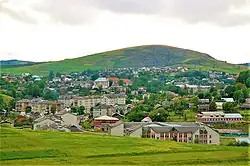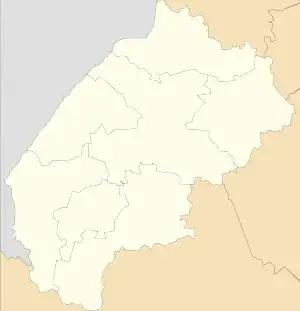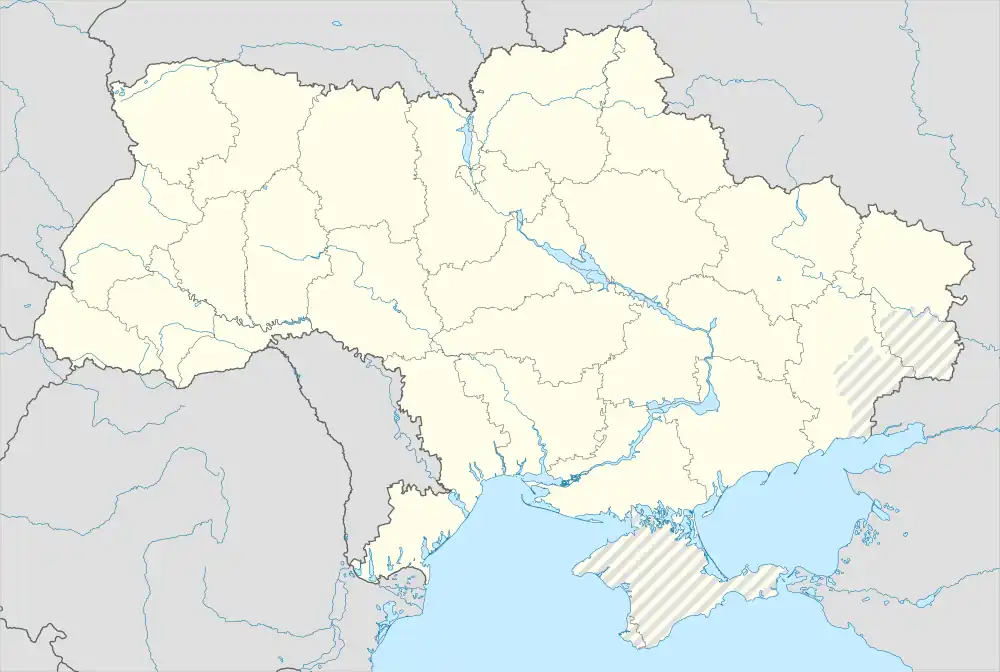Turka
Турка | |
|---|---|
 Turka panoramic view | |
 Flag  Coat of arms | |
 Turka Location of Turka  Turka Turka (Ukraine) | |
| Coordinates: 49°09′27″N 23°01′21″E / 49.15750°N 23.02250°E | |
| Country | |
| Oblast | |
| Raion | Sambir Raion |
| First mentioned | 1431 |
| Government | |
| • Mayor | Yaroslav Parashchych |
| Elevation | 557 m (1,827 ft) |
| Population (2022) | |
| • Total | 6,925 |
| Area code | +380 |
| Website | https://turka-mrada.gov.ua/ |
Turka (Ukrainian: Турка, Турка над Стрийом (old), Polish: Turka, Turka nad Stryjem (old), Yiddish: טורקא) is a city located at the confluence of the Stryi River and the Yablunka River in Sambir Raion, Lviv Oblast, western Ukraine. It is located by the Carpathian Mountains. It hosts the administration of Turka urban hromada, one of the hromadas of Ukraine.[1] Population: 6,925 (2022 estimate).[2]
Until 18 July 2020, Turka belonged to Turka Raion and was the administrative center. The raion was abolished in July 2020 as part of the administrative reform of Ukraine, which reduced the number of raions of Lviv Oblast to seven.[3]
Name
The name Turka originates from Ukrainian word, тур (tur), meaning aurochs or urus (Latin: Bos primigenius), the ancestor of domestic cattle — a type of huge wild cattle which inhabited in the surrounding forests (it survived in Europe until 1627).[4] In another version the city's name derives from the Ukrainian name of the gate-towers, "Turia" (Ukrainian: Tурія), "Turja" (Ukrainian: Тур'я), "Turnia" (Ukrainian: Турня), which stood at the entrance to an ancient settlement.
The origin of the name may also be linked to the Turks since the area was under the Hun Empire and they are considered as ancestors of Turks. Also, Turkic tribes were nomadic, settling in various places and assimilating.
Geography
Location
The city is located in the south Lviv Oblast, in the Carpathian Mountains, on the left bank of the Stryi River, with its tributaries, the Yablunka River (Ukrainian: Яблунька) and Litmyr River (Ukrainian: Літмир), and between the mountains Shymenka (Ukrainian: Шименка), Kychera (Ukrainian: Кичера), Vinets' (Ukrainian: Вінець) and Osovnya (Ukrainian: Осовня).
The city is located 137 km from Lviv, 107 km from Uzhhorod, 75 km from Drohobych, at an altitude of 557 meters above sea level. The location of initial settlement outpost, from which arose Turka, was determined by the so-called "Path of Rus" - Neolithic trade route that connected through the Turka Western Europe to Hungary, Moldova and the Balkan countries.
History

On June 27, 1431, King Władysław II Jagiełło presented Turka to a man named Vancza Valachus. This was confirmed in 1444 by King Władysław III of Poland, and by Sigismund I the Old in 1517. In 1730 Turka received Magdeburg rights, and three years laters, a Roman Catholic parish was opened here. Turka was administratively located in the Przemyśl Land, Ruthenian Voivodeship, Lesser Poland Province of the Kingdom of Poland. Following the First Partition of Poland, from 1772 to 1918 the town belonged to Austrian Galicia.
In the Second Polish Republic, Turka was the seat of a county in Lwów Voivodeship. It was home to a county court, private high school and tax office. At that time, its starosta was Tadeusz Zawistowski, and the mayor was Michał Grudziński.
Following the September 1939 Invasion of Poland, Turka was occupied by the Soviet Union. In June 1941, the town was captured by the Wehrmacht, and its Jewish population was murdered in the Holocaust. After World War II, the town was reattached to the Soviet Ukraine, and its Polish community was expelled to the so-called Recovered Territories.
Until 18 July 2020, Turka served as the administrative center of Turka Raion. The raion was abolished in July 2020 as part of the administrative reform of Ukraine, which reduced the number of raions of Lviv Oblast to seven. The area of Turka Raion was merged into Sambir Raion.[5][6]
Demography
| Year | Pop. | ±% |
|---|---|---|
| 1880 | 4,685 | — |
| 1916 | 6,080 | +29.8% |
| 1921 | 10,030 | +65.0% |
| 1931 | 10,145 | +1.1% |
| 1989 | 7,982 | −21.3% |
| 2001 | 7,440 | −6.8% |
| 2006 | 7,306 | −1.8% |
| 2022 | 6,925 | −5.2% |
| Source: [7][8][9][10][11][12][13] | ||
The population is 7,306 people in 1114 homes (2006) 99% of the population are Ukrainian.
Dynamics of population in the past:
- 1880 — 4,685 inhabitants (1,786 Rusyns, 537 Poles, 2,356 German; of them: 1,837 Greek-Catholic, 450 Catholics, 2,398 Jews).[7]
- 1916 — 6,080 inhabitants (including - 3,000 Jews)[8]
- 1921 — 10,030 inhabitants (52.4% Polish, 29.2% Ukrainian, 18.3% Jewish by nationality, 58.0% Catholic (Roman or Greek rite) and 41.9% Jewish by religion)[10]
- 1989 — 7,982 inhabitants (3,992 male, 3,990 female)[11]
Sights
- Church of the transfer of the relics of St. Nicholas, Turka (1776)
- Church of St. Nicholas, Turka (1739)
- Assumption of the Blessed Virgin Mary Church, Turka (1750)
- Protection of the Blessed Virgin Mary Church, Turka (1780)
- Church of Saints Peter and Paul, Turka (2003)
- Assumption Church, Turka (1778)
- Synagogue, Turka (19th century)
- Old Jewish Cemetery, Turka (19th century)
- Market Square, Turka
- Folk Museum of Boykos, Boykivshchyna (Ukrainian: Бойківщина)
- Museum of Boykos books
Notable people
- Abba Hushi (1898—1969) — Israeli politician, mayor of Haifa (1951–1969)
- Zygmunt Albert (1908—2001) — Polish doctor, pathologist, Professor of Medicine, President of Wrocław Medical University (1950–1954)
- Ihor Gerych (1961) — Ukrainian surgeon, Professor of Medicine, Нead of the regional ministries of health of Lviv Oblast (2005–2009)
- Mykhailo Melnyk (1889—1944) — Ukrainian military and political leader
- Ira Moskowitz (1912—2001) — American Graphic Artist
- Stepan Popel (1907—1987) — Ukrainian and American chess player, multiple chess champion of Lviv, Paris and eventually, of the Ukrainians in North America (United States and Canada)
- Karl Schein (1911—1973) — Polish and Israeli surgeon, Professor of Medicine, Chief surgeon of Polish army, director of the medical clinic in Haifa.
- Yuriy Tarnawsky (1934) — Ukrainian poet and novelist, one of the founding members of the New York Group, a Ukrainian émigré avant-garde group of writers, and co-founder and co-editor of the journal Novi Poeziyi (New Poetry; 1959–1972).
- Marian Promiński (1908—1971) — Polish poet, novelist, essayist, film critic, dramaturge, translator of Anglo-Saxon literature.
- Ivan Fedevych (1883—1939) — Ukrainian social and political leader, a Greek Catholic priest.
- Myron Utrysko (1908–1988) — Ukrainian social and political leader.
- Teodor Rożankowśkyj (1875—1970) — Ukrainian political and military leader, a lawyer, the first commander of the Legion of Ukrainian Sich Riflemen.
- Myron Yusypovych (1957) — Ukrainian artist chief conductor of the Symphony Orchestra K&K Phіlharmonіker of agency Da Capo Musіkmarketіng Gmbh, Austria, director of choir K&K Opernchor, Honored Artist of Ukraine
- Adam Karpinski (1897–1939) — Polish alpinist, a mechanical engineer, aircraft designer, pilot.
References
- ↑ "Турковская городская громада" (in Russian). Портал об'єднаних громад України.
- ↑ Чисельність наявного населення України на 1 січня 2022 [Number of Present Population of Ukraine, as of January 1, 2022] (PDF) (in Ukrainian and English). Kyiv: State Statistics Service of Ukraine. Archived (PDF) from the original on 4 July 2022.
- ↑ "Про утворення та ліквідацію районів". Офіційний вебпортал парламенту України (in Ukrainian). Retrieved 2023-12-29.
- ↑ Unofficial site of Turka (in Ukrainian)
- ↑ "Про утворення та ліквідацію районів. Постанова Верховної Ради України № 807-ІХ". Голос України (in Ukrainian). 2020-07-18. Retrieved 2020-10-03.
- ↑ "Нові райони: карти + склад" (in Ukrainian). Міністерство розвитку громад та територій України.
- 1 2 Turka in «Geographical Dictionary of the Kingdom of Poland (1880)
- 1 2 The American Jewish Year Book, 5677, September 28, 1916, to September 16, 1917, Edited by Cyrus Adler for the American Jewish Committee, Philadelphia, The Jewish Publication Society of America
- ↑ Wiadomości Statystyczne Głównego Urzędu Statystycznego (in Polish). Vol. X. Warszawa: Główny Urząd Statystyczny. 1932. p. 141.
- 1 2 Skorowidz miejscowości Rzeczypospolitej Polskiej (in Polish). Vol. XIV. Warszawa: Główny Urząd Statystyczny. 1923. p. 22.
- 1 2 "Table: 19A0501_04. Number of the population in urban settlements (1,2,3); 1989(12.01)". Main Statistical Office in L'viv. Retrieved 8 January 2018 – via database.ukrcensus.gov.ua: Select m. Turka in 'Territory' field, plus actual in 'Population category'
{{cite web}}: CS1 maint: postscript (link) - ↑ Registration card of Turka in the Parliament of Ukraine (in Ukrainian)
- ↑ Hyda J. "Turka - a New Capital Boikivshchyna" Tourism guide (Uzhhorod:Patent, 2006)(in Ukrainian)
External links
- Turka history and photos (in Ukrainian)
- Turka history (in Ukrainian)
- Turka in Geographical Dictionary of the Kingdom of Poland (1889)
- Memorial Book of the Community of Turka on the Stryj and Vicinity (Turka, Ukraine)
- Turka: slideshow
- Turka: history slideshow (1900-1935)
- Turka: Congress of Boykos (slideshow)
- Turka: Xsmas song (slideshow)
- Turka: City tour (slideshow)
- Turka: Homemade machine "Dyha" (slideshow)
- Turka, Ukraine | By Ukraine Channel
- Turka: photos